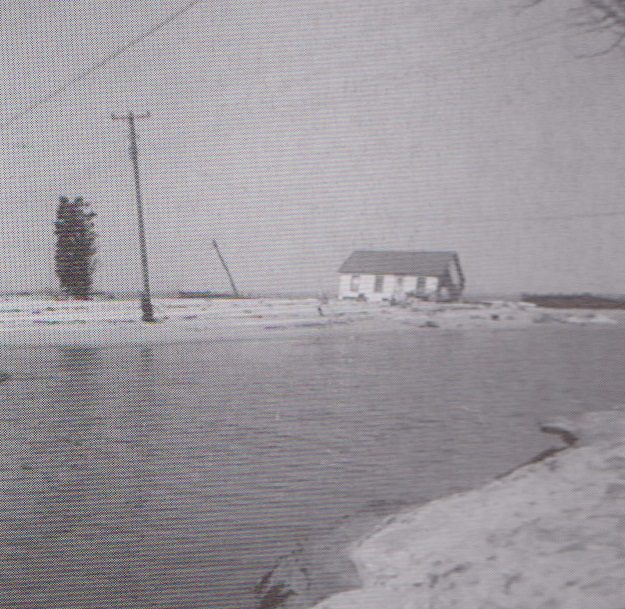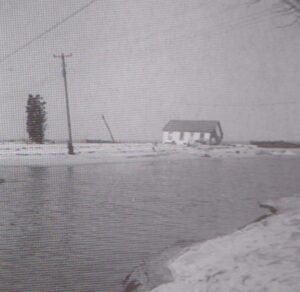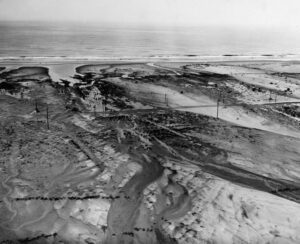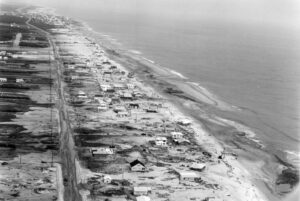March 5 will mark the 61st anniversary of the Great Ash Wednesday Storm of 1962. Even today, the storm is considered one of the most devastating to hit the Delmarva Peninsula, causing $50 million in damages which, today would total over $465 million. The nor’easter, which coincided with a spring tide, remained stationary over the area for almost 36 hours, causing flooding that lasted more than five hours. Although most devastating in the beach towns, especially Ocean City and Rehoboth Beach, even towns inland were affected.
According to the DVD “The ’62 Storm: Delaware’s Shared Response,” weather reports for the storm did not initially cause concern among locals. It was reported that a nor’easter would affect the region on March 5, but this was not unusual weather for Delaware during the month of March. However, by midnight on March 5, it was clear that it was not an ordinary storm.
Along the coast of Delaware, nor’easters are often more damaging than hurricanes. In fact, there has never been a direct hit from a hurricane along the Delaware shoreline, but nor’easters, named for the direction the winds circulate, are more common and more damaging. Nor’easters originate in the westerly wind belt and are considered sub-tropical. They derive power from temperature differences between cold and warm air masses, unlike hurricanes which need warm ocean water to survive. Hurricanes also occur in warm months while nor’easters can occur any time of the year. The most prevalent time of year, however, is autumn through spring with 63 percent occurring during this timeframe.
The storm was supposed to move up the coast and into New England, but the low was blocked by an upper level high, causing it to stall over the peninsula. The stall caused the storm to expand, increasing wind speeds significantly. The registered winds were higher than those experienced during Hurricane Hazel in 1954. Researchers into the storm today believe wind speeds reached over 112 miles per hour. The storm was so significant by midnight, Governor Elbert Carvel declared a state of emergency, ordering evacuations of the beach area. On March 9, President John F. Kennedy declared Delaware, Maryland, New Jersey and Virginia as disaster areas.
At that time, there were no gauges to tell how high ocean waves were, but eyewitnesses reported waves as high as 20 to 30 feet on March 7, 1962. The high waves along the coast pushed water into the bays and tributaries, causing flooding inland as well. Towns like Milford, Milton and Millsboro suffered significant flooding as rivers rose. Because the storm stalled for almost three days, the area dealt with five high tides during the storm and one of those tides is still the highest on record for the state.
Bowers and Slaughter Beach were affected by winds and high tides as well. Many of the homes built along the beaches were built using standards meant for homes built inland.
“Many people just laid joints along the marsh and built on top of them,” John Moyer Jr., who was interviewed on the DVD, said. “There was no foundation and no support. We had no warning at all about this storm. We had no idea how devastating it would be.” In fact, five of the seven fatalities in Delaware occurred in Bowers. According to Mr. Moyer, the Allen family lived on the point and, as the storm intensified, Mr. Allen attempted to evacuate his family. He placed his five children in the family car and went to convince his wife to leave. His wife was so frightened, she was reluctant to leave the home and, before she could be convinced, the car washed into the water, killing all five children.
Photos after the storm show downtown Milford streets that look more like a river. Humes Hardware and other businesses downtown suffered flooding. Near what is now Bicentennial Park, the flooding was significant, with water above the store windows. Homes in Slaughter Beach were destroyed, many falling forward onto the beach.
Even today, people recall seeing large boats along the road between Milford and Slaughter Beach. In some areas, prisoners were used to remove debris while young boys earned extra money shoveling sand or removing debris from beach homes.
The storm changed the many of the building codes along the Delaware coastline, making them more stringent and restrictive in order to protect people and property. The National Weather Service says that there have been storms as strong as the 1962 storm, but none have stalled over the area for that length of time, lessening the damage. The storm led to the Delaware Coastal Zone Act in 1971 which was designed to protect the coastline from extensive coastal development. The act banned construction in the middle of beaches which had been common practice prior to this storm. The Atlantic Sands Hotel, for example, stood in the center of Rehoboth Beach before the storm, but was forced to move back to its current location when they rebuilt.
RELATED STORIES:
Share this Post







